The complex balance of perspective in Marco Covi’s photos.
Architectural photography is a field based on precision and the visual interpretation of structures, where perspective and lines dominate the scene. Each image becomes a narrative that highlights the geometry and essentiality of the spaces, with a strong focus on details and light. The light, already present in the environment, cannot be modified but only captured, revealing its interaction with the surfaces and architectural forms.
As Ansel Adams said, “We must remember that a photograph can only contain what we have put into it, and no one has ever fully exploited the possibilities of this medium of expression” (Wikipedia). This reflection is fitting for analyzing the work of Marco Covi, who knows how to shape the balance of perspective, managing to document the depth and geometry of spaces while maintaining a connection to the architectural reality.
We had the pleasure of meeting Marco Covi on the sidelines of an event organized by Trieste Contemporanea in collaboration with Visual Hub at the Studio Tommaseo. The seminar, titled “Publishing and Photography for the Study of Contemporary Architecture,” was held on the occasion of the finissage of the exhibition.
Spazi di carta. Indagine sentimentale sull’editoria di architettura nel lungo secondo dopoguerra italiano (Paper Spaces. A sentimental investigation of architecture publishing in the long Italian post-war period) curated by Giulio Polita. During the event, Covi explored his vision of architectural photography, emphasizing the importance of taking a stance as a photographer, a concept that involves a personal choice reflecting one’s viewpoint on architectural reality. The conversation, led by Annalisa Polli of Visual Hub, also discussed the specificity of architectural photography, with examples from Friuli Venezia Giulia.
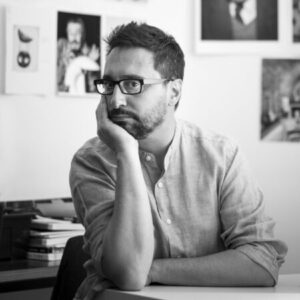 Marco Covi is a photographer who has created photographic campaigns for institutions and organizations, as well as editorial reports for various magazines. He has collaborated with renowned architecture and design studios, major industry publications, communication agencies in Italy and abroad, and leading companies in the design sector. Since 2007, he has been a regular collaborator with the Mondadori publishing house (Mondadori Arte, Electa, Mondadori Portfolio).
Marco Covi is a photographer who has created photographic campaigns for institutions and organizations, as well as editorial reports for various magazines. He has collaborated with renowned architecture and design studios, major industry publications, communication agencies in Italy and abroad, and leading companies in the design sector. Since 2007, he has been a regular collaborator with the Mondadori publishing house (Mondadori Arte, Electa, Mondadori Portfolio).
What inspired you to focus specifically on architectural photography?
It may sound trivial, and probably it is, but first of all, my interest in architecture, thanks to my university studies. Secondly, a decisive professional experience: the years spent at the Tassinari/Vetta studio, coinciding with their new editorial project for the magazine Casabella, where I did an initial selection work on the iconographic materials coming from various architecture studios or the Milan editorial office. Essentially, it was a mediation task between the inevitable abundance of original documentation and the necessary synthesis imposed by layout requirements: an exercise that turned out to be very valuable in learning the codes of architectural photographic representation, both in descriptive terms (such as which views are essential to represent a building) and, so to speak, narrative terms (the importance of a coherent path in the sequence of images).
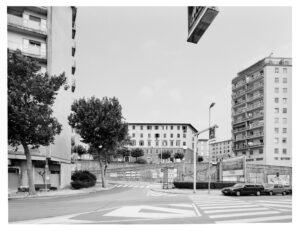
Your stylistic choices in architectural photography are very precise and recognizable. What are the obsessions that guide you when photographing buildings or spaces?
Although I have been photographing for many years now, during which I think I have developed my own way of looking, I am still surprised when someone points out that I have a ‘recognizable style.’ Of course, this is something I’m happy about, even though I am fully aware of the teaching of Walker Evans, perhaps my favorite photographer, to whom I would never dare compare myself. He, paraphrasing Flaubert, stated that the photographer should be like God, invisible and omnipotent. If I then try to think about my photographic obsessions, it seems that I have managed to give them a name more thanks to literature than through the practice of photography. I think, for example, of Peter Handke and Gianni Celati, in whom I found, albeit in very different registers, the same poignant tenderness towards the world, which manifests itself in looking outward, without expectations or prejudices, but also to the recent discovery of Jon Fosse, for whom the work must ‘come by itself, like an event, like a gift.’ However, nothing supernatural, it’s rather about imposing a discipline on the all-consuming hunger of the gaze; a patient exercise in education, I would say more to listening than to simply observing places – Evans himself said that one needs a ‘sophisticated ear’ – in order to, hopefully, reach that sensitivity which the great American photographer Stephen Shore defines as heightened awareness.
In addition to photography, you also teach at the GB Tiepolo Academy of Fine Arts in Udine. How do you approach teaching digital photography, and what skills do you aim to impart to your students?
In fact, my collaboration with the ABA Udine ended last year, while my work with the Vicenza branch of the IUAV of Venice continues with satisfaction, where since 2023 I have been responsible for the Photo/Video Workshop. In general, I consider the years of teaching very positive, as from the beginning I have experienced them as a great responsibility towards the students and as a valuable opportunity to question myself about the reasons for being a photographer, beyond a generic and insidious indulgence toward one’s own creativity. Obviously, a teaching path cannot be separated from the transmission of rules, what we can define as grammar, as well as the history of the medium in question. The fact that we are talking about digital photography is of relative importance, both from a historical perspective (we’re talking about just over twenty years in nearly two hundred) and a strictly linguistic one, if it can be said that way. What I have focused my teaching interests on the most are the linguistic mechanisms and the narrative potential of the transformation that photography brings to reality.
I proposed photographic projects to my students that involved visiting ‘ordinary’ places, that is, places seemingly devoid of apparent qualities, in order to establish a different relationship with them and the people who inhabit them, beyond the distracted way we usually approach them. Against the established rituals of communication, the challenge was to impose a different time dedicated to observing the sensible world, allowing stories to emerge beyond the surface, in a process of knowledge (or rather recognition, as the philosopher Byung-chul Han teaches), of which the photographic shot is just the last step.
Have you ever wondered what Walter Benjamin’s book The Work of Art in the Age of Its Technological Reproducibility would be like if it were written today, with new media and the infinite digital reproducibility?
I may be wrong, but it seems to me that not much has changed since then: that is the realm in which our aesthetic sensitivity has been shaped, and although it is a process of continuous and very rapid technological evolution (and perhaps a general decline in taste), I would say we are still within the horizon presented by Benjamin in the 1930s. If we think about it, in the meantime, painting and the other ‘non-reproducible’ arts certainly haven’t disappeared: since Cézanne, they have always found new spaces, new ways and languages in which to express themselves, even using the most innovative technologies. I like to think that this is the vocation of every artistic manifestation in the face of the eruption of novelty that shakes things up. Perhaps a new frontier could be represented by the advent of artificial intelligence, which seems to radically question a foundation that has endured in art for millennia and which has withstood the impact of photography and cinema: the relationship with reality. If painting had established a similarity with the world and photography transformed this relationship into a direct imprint of reality on the sensitive surface, here there is no longer any physical trace of the real, no light reflected by an object, no matter settling on a surface, whether analog or digital. Unlike photography, whose essence according to Barthes is the past, syntography seems to open up to an unsettling could be, an image always in the present tense, self-generating and regenerating without any relation to the sensible world. No longer imitation nor registration, but an elaboration that assumes the appearance of the real. Essentially, if ninety years ago the aura of the artwork diminished with technical reproducibility, what happens today when the image is no longer even a reproduction, but a pure simulation? Well, assuming my interpretation is correct, I would stop here, in the sense that I am unable to understand what relationship a syntograph has or doesn’t have with a reality of which it contains no trace, but to which it proposes to resemble much more than a painting could ever do. Upon further thought, perhaps the point is not even whether syntography has a connection with reality, but what model of reality it is proposing and how our perception is rapidly adapting to this new status of the image. I fear we should ask Benjamin himself.
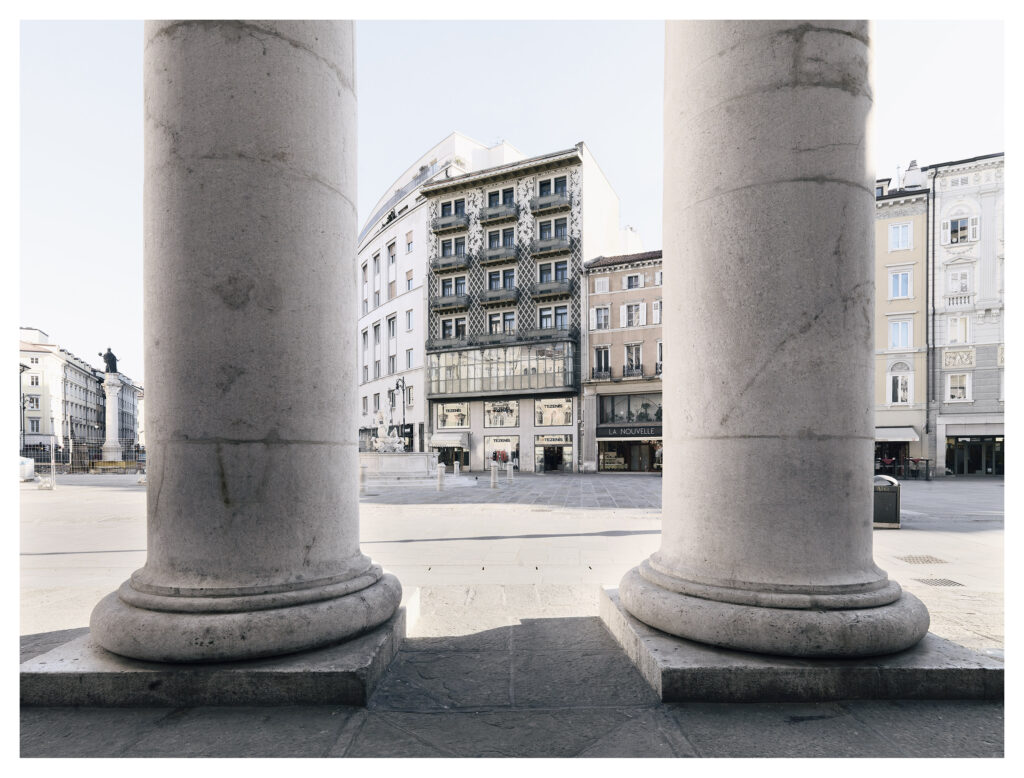
How do you think the concepts of uniqueness and authenticity in art have evolved?
I don’t believe that the concepts of uniqueness and authenticity in art are being questioned by new technologies, no more than painting had to fear the advent of photography or, to refer back to the previous question, no more than it was already evident in Walter Benjamin’s time. Since I do not consider myself an artist, I don’t think we should focus on the multitude of ‘sun worshipers,’ to quote Baudelaire, but rather recognize that there are – and I believe there will always be – vast areas for intervention in the way reality is translated through photography. I take to heart John Berger’s lesson on the appearances of the world as a legend, that is, literally as material to be read, to be patiently interrogated to bring out a (possible) meaning hidden beneath the surface.
In short, I believe that as long as there is reality to observe, the conditions will exist to preserve the uniqueness and authenticity of the work of art, regardless of the medium used. The current issue, in my opinion, lies in the fact that we have become accustomed to looking at the world by overlaying it with a predefined expectation of meaning – a meaning we already have in mind and simply seek confirmation for (from souvenir photos onwards) based on standardized and homogenizing categories. In short, we no longer know how to look without prejudice, and at the same time, we lack awareness of the act of looking. To stretch the terms of the discourse, I would say that we have replaced the window of Alberti, which opened onto the outside world to give form and structure to its two-dimensional representation, with the digital window of the smartphone, seemingly open to a much vaster reality but at the same time flattened onto a screen and impoverished because it lacks both the codes of interpretation and the physical experience of space. Very modestly, as I’ve already said, I find the challenge lies in the recognition of what is in front of our eyes. For example, I think of Paul Strand, who talked about how he let himself be called by the things he photographed – those that Jonathan Franzen recognizes as ‘the beauty of a second glance.’ Or, to stay within the literary realm, I cannot help but mention Scorze by Georges Didi-Huberman, a book that has accompanied me in recent years: the story of a journey to Birkenau in search of seemingly insignificant traces to reconstruct the memory of what is no longer visible. As Didi-Huberman warns: ‘One can never say: there is nothing to see, there is no more to see. To know how to doubt what one sees, one must know how to still see, see despite everything.’
Is there an aesthetic that you consider particularly “dangerous” or problematic in the world of contemporary photography and art?
I admit that I’m not particularly attentive to current trends in the artistic debate, but in general, I feel a sacred horror toward the logic of consumption and the neurotic rituals that characterize communication in the age of social media. Even Susan Sontag, in her earlier years, warned us about using photography as a surrogate for experience, but I don’t think she could have imagined the consequences of her insight. If, in the past, evening slide shows of vacation pictures – although sometimes exhausting – still represented a shared social experience, today we are immersed in a self-referential aesthetic of reward. The fetish of the like, to be obtained or given with mostly utilitarian purposes, reflects an obsessive need for approval, the illusion of emerging from the indifference generated by billions of images taken and ‘shared’ every day. This is a phenomenon that makes it impossible not to question. I, myself, have been reflecting on the conditions that allow for the ‘recycling’ of a photograph, understood as a new attribution of meaning in a narrative key. It’s a theme I find fascinating, as long as we remain firmly grounded in the practice of photography. I say this in reference to possible interpretations of so-called Post-Photography, theorized by Joan Fontcuberta, according to whom – simplifying due to my own limits and space – we are now so overwhelmed by photographic images that taking new ones has become redundant. Of course, these are interesting theories that have inspired projects of great depth; I think, for example, of Erik Kessels’ monumental work. But aging, along with many unpleasant consequences, brings with it an enriching independence of judgment, and I want to believe that between one aesthetic and another, there are still operational margins left for me as a photographer. After many years in commercial photography and overcoming a phase of necessary curiosity toward the most captivating trends, as well as the dynamics of social media and new technologies, my modest aspiration would essentially be to ‘retire’ into a silent dialogue with the appearances of the world. A need for visual hygiene, let’s say, to return to Sontag’s lesson.
In La Camera Chiara di Roland Barthes, the punctum is that element in a photograph that strikes the observer deeply, going beyond the simple reading of the image to evoke personal emotions and reflections.Is there a photograph that you consider particularly significant? Can you tell us the story that this photo does not convey?
I have always had a very critical relationship with my photos, and I honestly find it difficult to judge them as interesting. If they are, I believe that task should belong to an engaged and attentive observer. In fact, I think this is what Barthes refers to when he defines punctum as something that wounds the gaze, piercing through the surface of the image. If I have to choose one of my photographs, I would select a shot that is particularly significant to me—not for purely photographic reasons, but because of the circumstances that led to it. It was taken in San Francisco at the end of a difficult experience, both professionally and, as a consequence, personally. That day, reaching the ocean after a long walk quite literally symbolized a moment of liberation from what was weighing on me. The photograph captures an entirely ordinary scene, but for me, it had the force of an unexpected revelation. Time and movement seem suspended: in the center, a seagull floats in the sky while another rests on a post, ready to take flight. On the left, the shadow of a pier could be advancing or retreating, just as the ferry on the right is caught in mid-motion—either approaching or pulling away from the dock.
Two elements further enrich the image’s meaning. In the background, the ominous silhouette of Alcatraz looms, a reminder that salvation is not yet secure. But in contrast, the dark opening of a door in the bottom right corner seems to offer an escape route at the last moment.
Years later, looking at that photograph again, I finally understood why I had taken it and why it still felt so close to me. The key came from a well-known episode in Xenophon’s Anabasis: Greek soldiers, pursued by enemies and demoralized by a chaotic retreat, suddenly cry out in joy as they reach the sea—the longed-for escape route to safety.
That exclamation—The sea! The sea!—is where my personal punctum lies. That is the wound from which the meaning of this photograph emerges, or rather, its duration—a concept that is very dear to me.
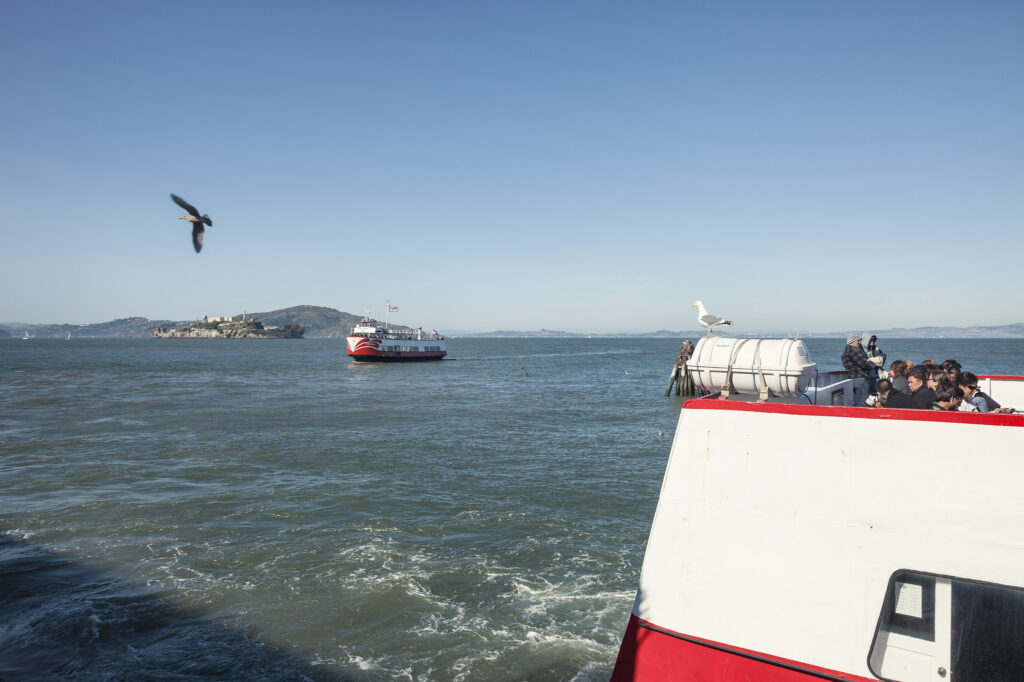
In the photos: portrait. Photos: Trieste and San Francisco
(all photos: courtesy of Marco Covi)

